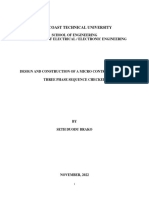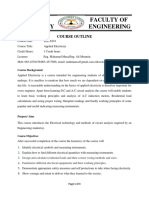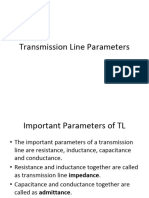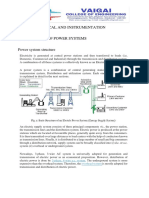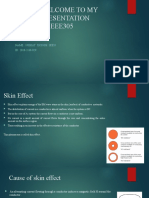Skin Effect
Skin Effect
When an alternating current “AC” flows through a conductor, it is
distributed non-uniformly throughout the conductor and tends to stay more
near the surface of the conductor. This phenomenon is called Skin Effect
which is applicable to AC only as the flow of current is uniform in the X-
section of conductors in case of DC.
Due to the said effect, the resistance of the wire increases, causing an increase
in line losses (waste of power occurring due to resistance of the power lines
I2R). The line losses occur in the form of heat which further increases the
resistance of the conductor. It reduces the efficiency of the transmission line.
Skin effect occurs in power transmission lines over a long distance. For
shorter distances, it does has no significance and pretty much doesn’t count.
Page 1 of 8
Engr Muhammed Zeeshan
� Skin Effect
But power transmission over long distances has a much more significant
skin effect.
Skin effect increases with an increase in frequency. If the frequency is very
high, the charge distribution or the current density stays maximum at the
very surface and forms a thin layer while the current density at the inner
cross-sectional area or the core remains zero.
Skin effects maintain the current flow between the outer surface and a fixed
depth from the surface called skin depth, δ. The skin depth varies inversely
with frequency.The skin depth can be calculated using the following
formula.
Skin Depth = δ = 7.6 ÷ √ (f) … (cm)
As Direct Current DC has no frequency, the distribution of current flow is
uniform throughout the conductor. It utilizes the whole cross-sectional area
of the conductor reducing the line losses to a minimum. But modern power
transmission uses alternating current having 50/60 Hz and also high-
frequency application at the range of gigahertz are quite affected by it.
Skin effect occurs
Let us consider the conductor is made up of a number of concentric
cylinders. When a.c is passed in a conductor, the magnetic flux induces in it.
The magnetic flux linking a cylindrical element near the center is greater
than that linking another cylindrical element near the surface of the
conductor. This is due to the fact that the center cylindrical element is
surrounded by both the internal as well as the external flux, while the
external cylindrical element is surrounded by the external flux only.
The self-inductance in the inner cylindrical element is more and, therefore,
will offer a greater inductive reactance than the outer cylindrical element.
Page 2 of 8
Engr Muhammed Zeeshan
� Skin Effect
This difference in the inductive reactance gives a tendency to the current to
concentrate towards the surface or skin of the conductor.
The current density is maximum at the surface of the conductor and
minimum at the center of the conductor. The effect is equivalent to a
reduction of the cross-section area of the conductor and, therefore the
effective resistance of the conductor is increased.
Causes of Skin Effect
Let’s consider that a solid conductor is used to conduct alternating current.
The cross-sectional area of the conductor is divided into very small
concentric circles that can carry a very small current as shown below.
When the alternating current is passed through the conductor, each cylinder
carries a fraction of the current and produces magnetic flux. Therefore there
is a magnetic flux linkage between the individual cylinders throughout the
conductor.
The magnetic flux linkage at the center cylinders is greater than those near
the surface of the conductor. It is due to the fact that the cylinders at the core
are surrounded by both internal and external magnetic flux while the surface
Page 3 of 8
Engr Muhammed Zeeshan
� Skin Effect
cylinders are only affected by external magnetic flux. Therefore the magnetic
flux linkage increases as we move near the core.
Inductance is directly proportional to the flux linkage therefore the
inductance also increases toward the core. The cylinders near the core have
high inductance as compared to the ones near the surface. Therefore, the core
has higher inductive reactance as compared to the near the surface.
The electrical current follows low reactance path.
Therefore, the alternating current tends towards the surface of the conductor
due to low reactance. The current density is lower near the core while higher
towards the surface of the conductor forming a non-uniform distribution of
charge known as the skin effect.
Factors Affecting Skin Effect
There are certain factor that affects the skin effect as follows.
Frequency
The current frequency is the main factor affecting skin effect and it is directly
proportional to the skin effect. As we know that inductive reactance is given
by
XL = 2π f L
Inductance reactance is directly proportional to frequency. Increasing the
frequency increases the reactance and decreases the skin depth of the
conductor. Thus the current stays more to the surface or the skin effect
increases.
Since DC has no frequency, its reactance is zero and the current is distributed
uniformly throughout the conductor.
Page 4 of 8
Engr Muhammed Zeeshan
� Skin Effect
Shape of Conductor
The skin effect also depends on the shape of the conductor. Conductors are
either solid or standard. The stranded conductor has a greater surface area
as compared to a solid conductor of the same size. As the AC tends to stay
at the surface, the stranded conductor has a less skin effect as compared to
the solid conductor. It means AC is more efficient for transmission in
stranded conductors than in solid conductors.
Diameter of Conductor
The skin effect is directly proportional to the diameter of a conductor. It
increases with an increase in diameter. It means it is minimum in conductors
having a smaller diameter. As a matter of fact, if the radius of the conductor
remains smaller than the skin depth, there will be no or minimum skin effect.
Material
The material is the conductor also affects the skin effect. It actually depends
on the permeability of the material. It is the property of the material to
support magnetic flux. A material having higher permeability is more
affected by skin effect than the one having lower permeability. It allows
higher magnetic flux linkage which increases the inductive reactance
causing to force the alternating current to stay on the surface.
Temperature
The temperature of the conductor is also directly proportional to the skin
effect in that conductor since temperature directly affects the resistance of
the conductor.
Disadvantages of Skin Effect
Skin effect has a negative impact on electrical power transmission. Here are
some disadvantages explained below
Resistance of Conductor
Page 5 of 8
Engr Muhammed Zeeshan
� Skin Effect
As we know skin effect reduces the effective area of the conductor because
most of the current flow on the surface and the core of the conductor remains
empty. The resistance is given by
R = ρl/A
Resistance R is inversely proportional to the area of the conductor. Since the
effective area of the conductor is reduced, the effective resistance of the
conductor increases.
Transmission losses
Also known as copper losses are the dissipation of energy in the conductor
due to the resistance of the conductor. It is measured by I2R. The energy is
wasted in the form of heat. As the resistance of the conductor increases due
to the skin effect, the losses increases. Thus damaging the conductor.
Voltage Drop
There is a voltage drop across the transmission line due to the resistance of
the conductor. As we know, the resistance increases, and the voltage drop
across the conductor also increases, causing a reduction in the transmission
voltage.
Cost
The cost of the transmission line increases due to the skin effect. It is due to
the fact that the resistance of the line increases and to compensate for the
resistance, another conductor is installed in parallel to distribute the load.
Thus increasing the cost.
Efficiency
Skin effect reduces the efficiency of the transmission line as the voltage drop
and power losses increases across the line.
Page 6 of 8
Engr Muhammed Zeeshan
� Skin Effect
Waste of material
The conductor is not utilized as most of our cross-sectional area has very low
or no current density. The material in the non-effective area i.e. in the core
of the conductor is wasted.
Method to Reduce Skin Effects
There are certain methods to minimize the skin effects in a conductor during
power transmission
Using Stranded Conductors
Stranded conductors have less diameter and increased surface area. Whereas
a solid core conductor has less surface area. Thus using a stranded conductor
reduces the skin effect.
Overhead power transmission lines use bundle conductor ACSR
(Aluminum Conductor Steel Reinforced). Bundled Conductors are several
conductors connected pretty phase in closed proximity.
Using Hollow Conductors
High-frequency RF applications use hollow conductors to eliminate the core
and increase the surface area of the conductor. Thus reducing the skin effect
Reducing Frequency
Frequency of the alternating current increases the skin effect. Direct Current
DC has zero frequency, hence it has no skin effect. Maintaining low
frequency for transmission over long distance greatly reduce the skin effects.
Type of Material
A material having lower magnetic permeability has a lower skin effect as it
has lower inductance reactance and reduced resistance.
Page 7 of 8
Engr Muhammed Zeeshan
� Skin Effect
Distance
Skin effect is more significant when transmitting power over a long distance.
Therefore, a high-frequency circuit should be placed at short distances to
reduce the skin effects and be more efficient.
High Voltage
Transmitting power using high voltage reduces the current in the
transmission line. And reducing the amount of current reduces the reactance
of the line thus reducing the skin effect.
Page 8 of 8
Engr Muhammed Zeeshan



